Key Points:
- A striking anatomical feature, tusks are the sole preserve of marine or terrestrial mammals.
- They serve a variety of purposes and may be used to aid locomotion, combat foes, or dig for sustenance.
- Tusks are basically dentine cased in enamel. They are distinct from horns, which are covered in keratin.
You may be surprised to learn how many animals have tusks. First, we need to know the difference between tusks and horns. Tusks are the front teeth of mammals that protrude outside of their mouths and keep growing throughout the animal’s life. Horns project from the animal’s head and are made of a bony core covered in keratin. The horns on the nose of a rhinoceros are a bit different in that they’re made of keratin with no bony core. Horns are not only different from tusks, but they’re different from antlers in that they’re not shed and grow back. The following are seven animals that have tusks:
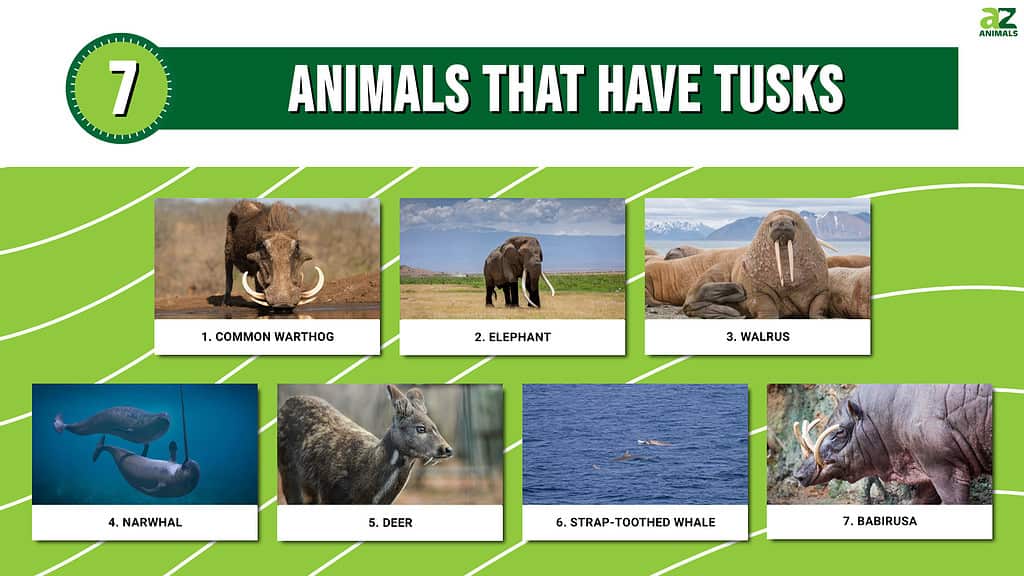
1. Common Warthog

A warthog has two pairs of tusks, with males using their upper tusks in ritual combat with other males.
©Peter van Dam/Shutterstock.com
Blessed with a face only a mother could love, this member of the Suidae family is found in much of sub-Saharan Africa. Its head, disproportionately large compared to the rest of it, bears not only tusks but facial warts or wattles. Moreover, the animal has not one but two pairs of tusks. Males use their upper tusks in ritual combat with other males but are wary about using their lower tusks, which can inflict serious injury. The tusks are 10 to 25 inches long in the boars and smaller in the sows.
Read here to learn more about the warthog.
2. Elephant

An elephant can be right- or left-tusked. You can tell which tusk the elephant favors as it will be more worn down.
©Stu Porter/Shutterstock.com
The magnificent tusks of elephants, especially the African elephant, have been the death of too many of them. The elephant’s tusks are made of ivory, which is made of the same materials human teeth are made of, which are dentin and enamel. The problem with elephants is that there’s simply a lot more of it, and humans have coveted it for centuries.
The tusks of an African elephant are gently curved and can grow to nearly 11.5 feet long. They are used to dig, lift, pull the bark from trees, fight and protect the elephant’s trunk. Interestingly, an elephant can be either right- or left-tusked the way a person can be right or left-handed. You can tell which tusk the elephant favors because it will be more worn down than the other one.
Though both sexes of the African elephant have tusks, tusks are restricted to the male in Asian elephants. However, thanks to intensive poaching, more and more African elephants are being born that do not develop long tusks. This is because the animals with the longest tusks are being removed from the gene pool.
Read here and here and here to learn more about elephants.
3. Walrus
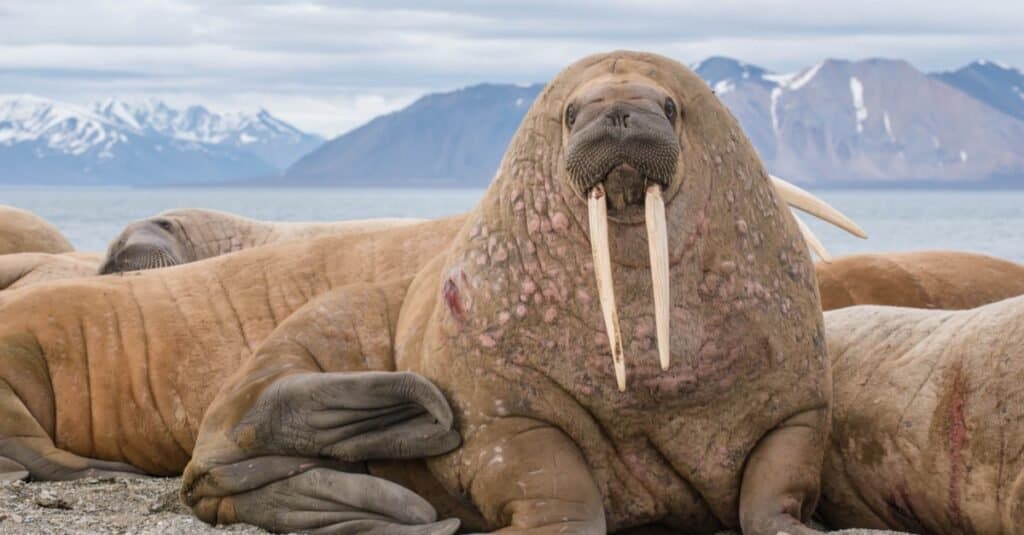
Walrus tusks can be as long as 3.25 feet and weigh 12 pounds.
©Mikhail Cheremkin/Shutterstock.com
Found along the coastlines and on the ice floes of the Arctic Ocean, the walrus is the only pinniped known to grow tusks. In a big male, these tusks can be as long as 3.25 feet and weigh 12 pounds. Females also have tusks but they’re shorter. The tusks are used to dig holes in the ice floes and helps the animal haul out of the water onto the same ice floes. Sailors used walrus tusks, among other sources of marine ivory, to create scrimshaw.
For more information about walruses, go here.
4. Narwhal
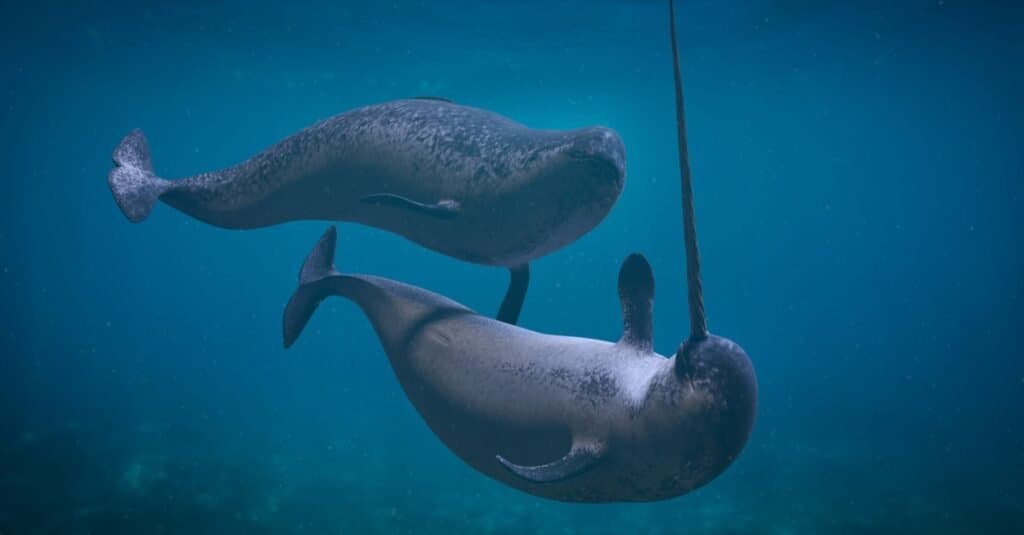
The narwhal’s tusk can reach more than 10 feet long to spar, punch holes in the ice, and search for and stun prey.
©iStock.com/dottedhippo
Most creatures with tusks have at least one pair, but the narwhal has only one tusk. Found even farther north than the walrus, the male of this whale has a single tusk that grows out of the left side of its face. indeed, it is an upper canine tooth that penetrates through the upper lip and has a clockwise spiral. The narwhal’s tusk, which is hollow, can be over 10 feet long and weigh 22 pounds. Once in a while, there is a female with a tusk or a male with a pair.
Males use their one tusk to spar with each other at mating time, though some scientists believe that the males are actually exchanging information, as the tusk is full of nerves. Narwhals also use the tusk to punch breathing holes in the ice or to search for prey on the seabed. They also use it to stun prey much like a billfish. The whale has no other proper teeth but its tusk. Narwhals often swim in schools and have a large repertoire of sounds to warn each other of predators and for finding prey.
Go here to learn more about narwhals.
5. Deer
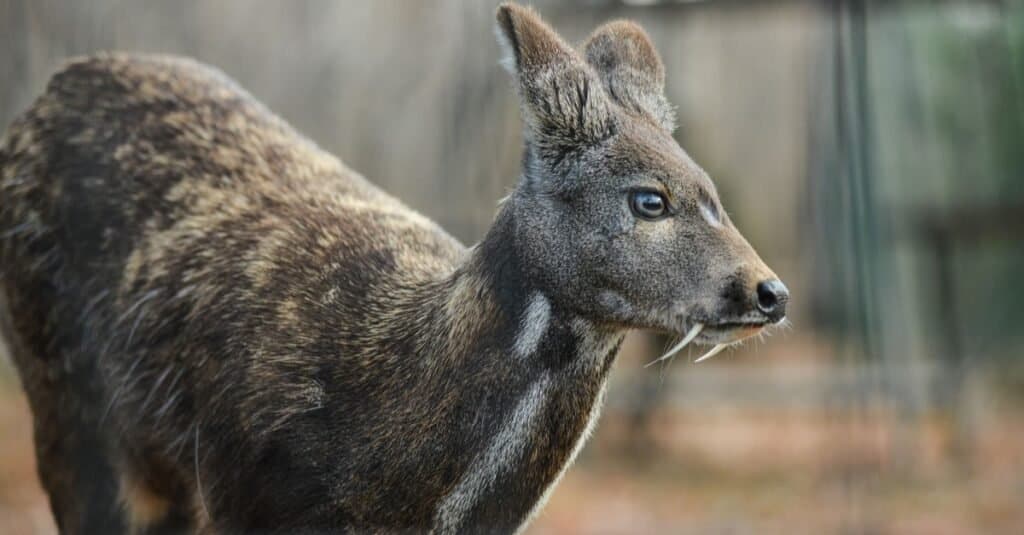
The
Siberian
musk deer is a rare hoofed animal with tusks.
©Suvorov_Alex/Shutterstock.com
The idea of a deer having tusks may sound freakish, but the water deer, water chevrotain, and musk deer all have tusks. Not only do these little deer have tusks, but they also lack antlers as if nature was being conservative with her gifts. These deer have been given the moniker “Vampire Deer.” The muntjac, found in southern Asia, also has rather enlarged canines that biologists hesitate to call proper tusks, and it also has antlers.
To be fair, biologists are not quite certain that the musk deer, one of seven species of the genus Moschus, is a proper deer. It not only has tusks and no antlers, but it also has a gallbladder, which other deer don’t have. Females have only one pair of teats, and males have that musk gland whose secretions humans covet. These deer are found in Asia, and the tusks, like the musk glands, belong to the males. They are upper incisors that grow as long as 4 inches.
The chevrotain, also called the mouse deer because of its tiny size, is also rather deer-like. The size of a large rabbit, it is an attractive little animal with fawn-like spots and stripes on a brownish-red ground that camouflages it as it moves through tropical forests of Africa.
Found, like the musk deer, in Asia, the water deer male also has notable tusks and no antlers. This creature is a member of the Cervidae family, so it is considered a true deer like the muntjac. It has powerful hind legs, so when it flees it jumps away like a rabbit. What’s interesting and rather alarming about the tusks of this deer is that they can be drawn in and pushed out, much like the fangs of the vampire of myth and legend. For example, the buck will pull his tusks in to eat but flash them to a rival male.
Read here and here for more information about these animals.
6. Strap-Toothed Whale
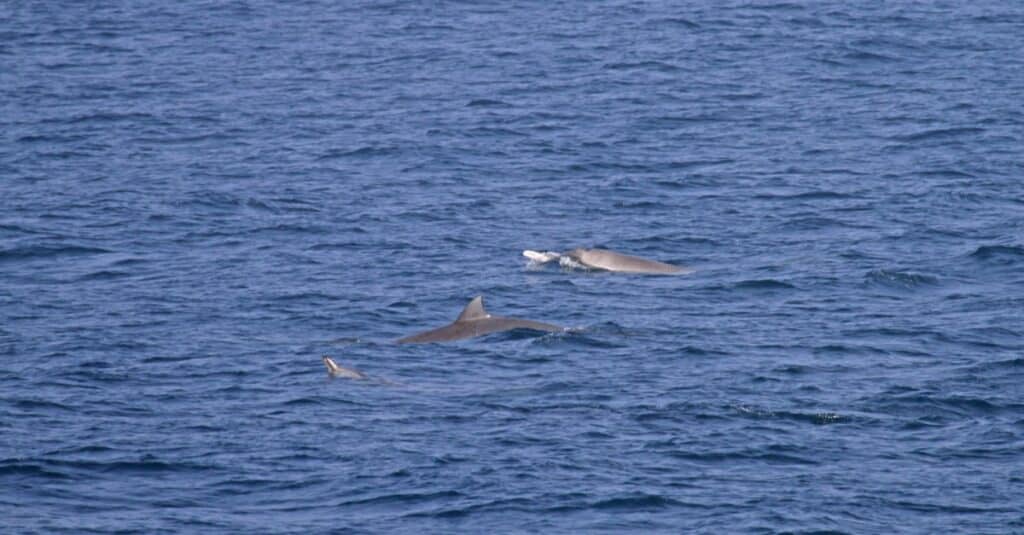
The strap-toothed whale is not able to open its mouth very wide until the tusks are well developed.
©Agami Photo Agency/Shutterstock.com
This common beaked whale, which can grow to 20 feet, is found in the colder parts of the southern oceans. It is easily recognizable because of its black and white coloration. The beak is white, there’s a black mask over the face, a white patch on the throat, and a white cape that stretches from the top of the head almost to the small dorsal fin. There’s also a white patch on the belly. The rest of the animal is glossy blue-black.
But besides its coloration, what makes this animal stand out are the male’s tusks. These tusks grow from each side of the animal’s lower jaw. Eventually, they grow out of the mouth and stretch back at a 45-degree angle until they touch or overlap at their ends. The ends of these tusks, which are rather paddle-shaped, have little denticles. If you’re wondering how the animal can open its mouth to eat, the answer is it can’t open its mouth very wide once the tusks are well developed. The male has to suck food into its beak, but the two overlapping tusks help channel the food.
Read here for more information about whales.
7. Babirusa
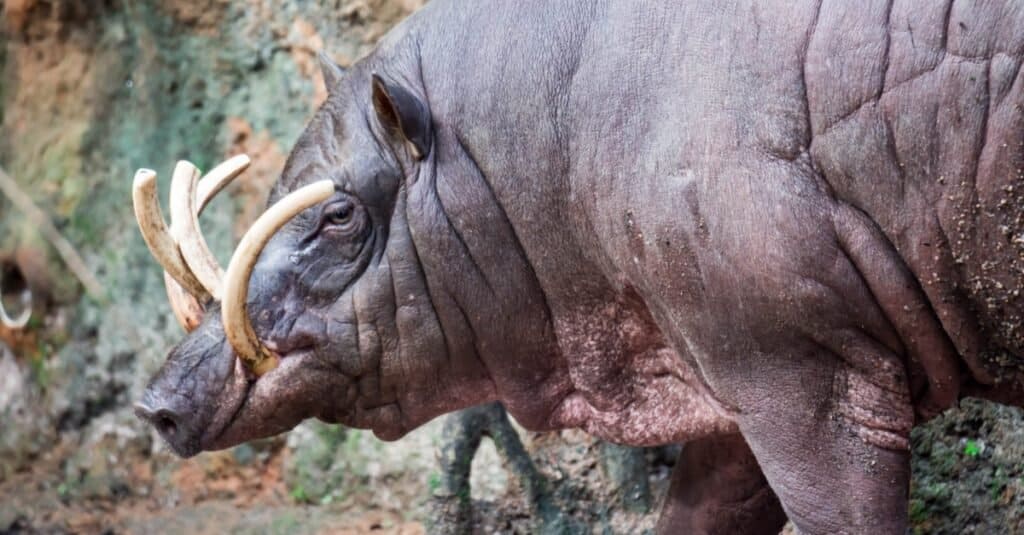
The male babirusa’s upper canines grow until they pierce through the top of its snout and curve backward.
©Bill Roque/Shutterstock.com
This wild pig is found in the rainforests and along bodies of freshwater in Sulawesi and nearby islands. It is a bit more pig-shaped than its cousin the warthog and also has a couple of pairs of tusks. The difference is that the upper canines of the male babirusa are not even found in its mouth but grow from the side of its upper jaw until they pierce through the top of its snout. Then, they curve backward till they form a type of cage over the babirusa’s face. In at least one species, the upper tusks meet. They can grow so long that they can pierce the animal’s skull or eyes. Not only this, but babirusa boars also have lower tusks that protrude through the side of their mouth. The tusks give the animal its name, which translates into “pig deer,” for the tusks are so long and curved they look like deer antlers on its face.
To learn more about the babirusa, go here.
Summary of 7 Animals That Have Tusks
Here’s a recap of the seven animals that possess tusks, not horns, that we looked at.
| Number | Tusked Mammal | Type of Tusks |
|---|---|---|
| 1 | Common Warthog | Two pairs of tusks 10-25 inches long in boars, smaller in sows |
| 2 | Elephant | Gently curved and can grow to nearly 11.5 feet long |
| 3 | Walrus | Can be as long as 3.25 feet and weigh 12 pounds; females also have tusks but they’re shorter |
| 4 | Narwhal | One hollow tusk that can be more than 10 feet long and weigh 22 pounds |
| 5 | Deer | Water deer, water chevrotain, and musk deer have tusks and no antlers |
| 6 | Strap-Toothed Whale | Tusks grow from each side of its lower jaw, out of the mouth and back at a 45-degree angle until they touch or overlap at ends |
| 7 | Babirusa | Upper canines of male babirusa grow from the side of its upper jaw until they pierce through the top of its snout then curve backward to form a type of cage over its face |
The photo featured at the top of this post is © Johan Swanepoel/Shutterstock.com
Thank you for reading! Have some feedback for us? Contact the AZ Animals editorial team.






